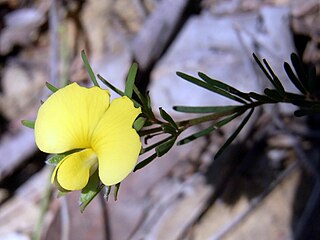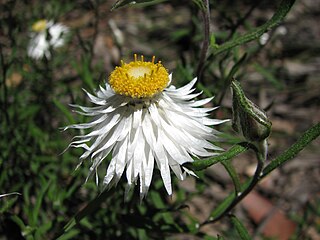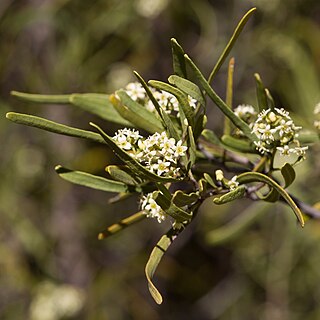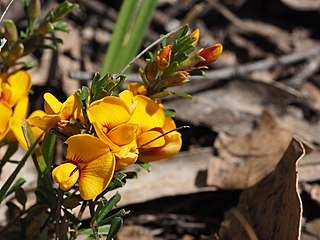
Dillwynia tenuifolia is a species of flowering plant in the family Fabaceae and is endemic to eastern New South Wales. It is an erect shrub with linear leaves, and orange-yellow and red flowers.

Banksia horrida, commonly known as prickly dryandra, is a species of shrub that is endemic to Western Australia. It has hairy stems, linear, pinnatifid leaves with sharply pointed teeth on the edges, up to sixty cream-coloured flowers in each head and hairy, egg-shaped follicles.

Grevillea armigera, also known as prickly toothbrushes or thorny grevillea, is a species of flowering plant in the family Proteaceae and is endemic to the south-west of Western Australia. It is an erect to spreading shrub with deeply-lobed leaves, the lobes linear and sharply pointed, and grey, green or pale yellow flowers with black to maroon styles.

Olearia pimeleoides, commonly known as pimelea daisy-bush, is a species of flowering plant in the family Asteraceae and is endemic to southern continental Australia. It is an erect shrub with elliptic, linear or lance-shaped leaves, and white and pale yellow, daisy-like inflorescences.

Gompholobium glabratum, commonly known as dainty wedge-pea, is a species of flowering plant in the family Fabaceae and is endemic to south-eastern continental Australia. It is a low-lying or ascending shrub with pinnate leaves that have five to seven leaflets, and yellow and green or greyish flowers.

Helichrysum leucopsideum, commonly known as satin everlasting, is a flowering, perennial herb in the family Asteraceae. It is grows in all states of Australia except Queensland and the Northern Territory. It has white, terminal flower heads and narrow, woolly leaves.
Persoonia rudis is a species of flowering plant in the family Proteaceae and is endemic to the south-west of Western Australia. It is an erect shrub with hairy young branchlets, linear leaves, and yellow flowers borne in groups of five to thirty on a rachis 3–100 mm (0.12–3.94 in) that continues to grow after flowering.

Olearia decurrens, commonly known as the clammy daisy bush, is a species of flowering plant in the family Asteraceae and is endemic to arid, inland Australia. It is a glabrous, sticky, twiggy shrub with narrow egg-shaped to linear leaves sometimes with toothed edges, and white and yellow, daisy-like inflorescences.

Geijera linearifolia, commonly known as oilbush or sheepbush, is a species of shrub in the family Rutaceae and is endemic to southern Australia. It has simple linear to oblong leaves, much-branched cymes of greenish-white flowers, and fruit containing a shiny black seed.

Dillwynia acicularis is a species of flowering plant in the family Fabaceae and is endemic to New South Wales. It is an erect shrub with linear, grooved leaves and yellow flowers with red markings.

Dillwynia rudis is a species of flowering plant in the family Fabaceae and is endemic to eastern New South Wales. It is an erect shrub with warty, linear leaves and yellow to orange flowers with red veins.

Pultenaea capitellata, commonly known as hard-head bush-pea, is a species of flowering plant in the family Fabaceae and is endemic to south-eastern continental Australia. It is a sprawling to prostrate shrub with elliptic to broadly egg-shaped leaves, and yellow to orange flowers with a red to purple keel.

Pultenaea echinula, commonly known as curved bush-pea, is a species of flowering plant in the family Fabaceae and is endemic to a small area of New South Wales. It is an erect shrub with linear, needle-shaped, grooved leaves, and dense clusters of yellow to orange and red flowers.

Pultenaea euchila, commonly known as orange pultenaea, is a species of flowering plant in the family Fabaceae and is endemic to eastern Australia. It is an erect shrub with glabrous foliage, narrow egg-shaped leaves with the narrower end towards the base, and orange-coloured flowers arranged singly or in small groups near the ends of branchlets.

Pultenaea microphylla is a species of flowering plant in the family Fabaceae and is endemic to eastern Australia. It is an erect to prostrate shrub with narrow egg-shaped leaves with the narrower end towards the base, and clusters of up to ten yellow to red flowers with reddish markings.

Bossiaea lenticularis is a species of flowering plant in the family Fabaceae and is endemic to eastern New South Wales. It is a slender, spreading shrub with mostly circular leaves, and yellow and red flowers.

Pultenaea parviflora, sommonly known as Sydney bush-pea, is a species of flowering plant in the family Fabaceae and is endemic to eastern New South Wales. It is usually a small, erect shrub with wedge-shaped to narrow egg-shaped leaves with the narrower end towards the base, and clusters of yellow to orange and red flowers.

Pultenaea spinosa, commonly known as grey bush-pea or spiny bush-pea, is a species of flowering plant in the family Fabaceae and is endemic to south-eastern continental Australia. It is a low-lying to erect shrub with glabrous stems, egg-shaped to rhombic leaves, and yellow-orange and red, pea-like flowers.
Pultenaea villifera is a species of flowering plant in the family Fabaceae and is endemic to two disjunct areas of Australia. It is an erect to prostrate shrub with triangular to linear, egg-shaped to elliptic leaves and yellow and red, pea-like flowers.
Olearia elaeophila is a species of flowering plant in the family Asteraceae and is endemic to the south-west of Western Australia. It is a small shrub with scattered linear leaves, and white or blue and yellow, daisy-like inflorescences.


















